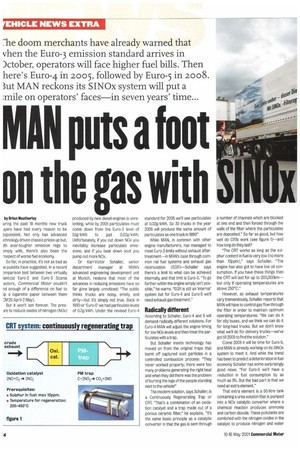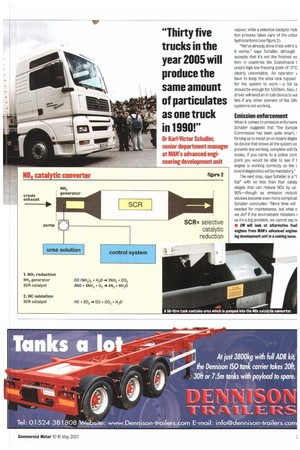MAN puts a foot on the as with
Page 24

Page 25

If you've noticed an error in this article please click here to report it so we can fix it.
by Brian Weatherley uring the past 18 months new truck Jyars have had every reason to be aspondent. Not only has advanced ichnology driven chassis prices up but, ith ever-tougher emission regs to 3mply with, there's also been the ^ospect of worse fuel economy.
So far, in practice, it's not as bad as le pundits have suggested. In a recent am parson test between two virtually lentical Euro-2 and Euro-3 Scania actors, Commercial Motor couldn't nd enough of a difference on fuel to ip a cigarette paper between them N26 April-2 May).
But it won't last forever. The oresire to reduce oxides of nitrogen (ND() produced by new diesel engines is unrelenting, while by 2005 particulates must come down from the Eura-3 level of 0.1g/kWh to just 0.02g/kWh. Unfortunately, if you cut down NOx you inevitably increase particulate emissions; and if you beat down soot you pump out more NOx.
Dr Karl-Victor Schaller, senior department manager at MAN's advanced engineering development unit at Munich, reckons that most of the advances in reducing emissions have so far gone largely unnoticed: "The public thinks trucks are noisy, smelly and dirty—but it's simply not true. Back in 1990 or 'Euro-0' we had particulate levels of 0.7g/kWh. Under the revised Euro-4 standard for 2005 we'll see particulates at 0.04/kWh. Sc 35 trucks in the year 2005 will produce the same amount of particulates as one truck in 1990!"
While MAN, in common with other engine manufacturers, has managed to meet Euro-3 limits without exhaust aftertreatment—in MAN's case through common rail fuel systems and exhaust gas recirculation (EGR )—Schaller says there's a limit to what can be achieved internally, and that limit is Euro-3. "To go further within the engine simply isn't possible," he warns. "EGR is still an 'internal' system but for Euro-4 and Euro-5 we'll need exhaust gas treatment."
Radically different
According to Schafer, Euro-4 and 5 will demand radically different solutions. For Euro-4 MAN will adjust the engine timing for low NOx levels and then treat the particulates with a trap.
But Schaller insists technology has moved on from the original traps that burnt off captured soot particles in a controlled combustion process: "They never worked properly; there were too many problems generating the right heat and when they did there was the problem of burning the legs of the people standing next to the vehicle!"
The modern solution, says Schaller, is a Continuously Regenerating Trap or CRT. "That's a combination of an oxidation catalyst and a trap made out of a porous ceramic filter," he explains. "It's the same basic principle as a catalytic converter in that the gas is sent through a number of channels which are blocked at one end and then forced through the walls of the filter where the particulates are deposited." So far so good, but how well do CRTs work (see figure 1)--and how long do they last?
"The CRT works as long as the sulphur content in fuel is very low (no more than 1Oppm)," says Schaller. "The engine has also got to have low oil consumption. If you have these things then the CRT will last for up to 200,000kmbut only if operating temperatures are above 250°C."
However, as exhaust temperatures vary tremendously, Schaller reports that MAN will have to control gas flow through the filter in order to maintain optimum operating temperatures: "We can do it for city buses, and we think we can do it for long-haul trucks. But we don't know what we'll do for delivery trucks—we've got till 2005 to find the solution."
Come 2008 it will be time for Euro-5, and MAN is already working on its SINOx system to meet it And while the trend has been to predict a deterioration in fuel economy Schafer has some surprisingly good news: "For Euro-5 we'll have a reduction in fuel consumption by as much as 5%. But the bad part is that we need an extra element."
That extra element is a 50-litre tank containing a urea solution that is pumped into a NDx catalytic converter where a chemical reaction produces ammonia and carbon dioxide. These pollutants are combined with the nitrogen oxides in the catalyst to produce nitrogen and water vapour, while a selective catalytic redt tion process takes care of the unbw hydrocarbons (see figure 2).
"We've already done trials with it a it works, says Schaller, although accepts that it's not the finished so tion: in countries like Scandinavia t urea's high low freezing point of -11°C clearly unworkable. An operator 1, have to keep the urea tank topped for the system to work--a full ta should be enough for 1,000km. Also, t driver will need an in-cab device tows him if any other element of the SIN, system is not working.
Emission enforcement
When it comes to emission enforcemE Schaller suggests that "the Europe Commission has been quite smart. I forcing us to install an on-board diagnt tic device that shows all the system co ponents are working, complete with fa codes. If you came to a police cont point you would be able to see if t engine is working correctly as the board diagnostics will be mandatory."
The next step, says Schaller is a "( Kat'' wlth no less than four cataly stages that can reduce NOx by up 90%—though as emission reducti devices become even more complicat Schaller concludes: "More time will needed for maintenance, but what c we do? If the environment ministers 1 us it's a big problem, we cannot say ni
• CM will look at alternative fuell engines from MAN's advanced engine( ing development unit in a coming issue.








































































































